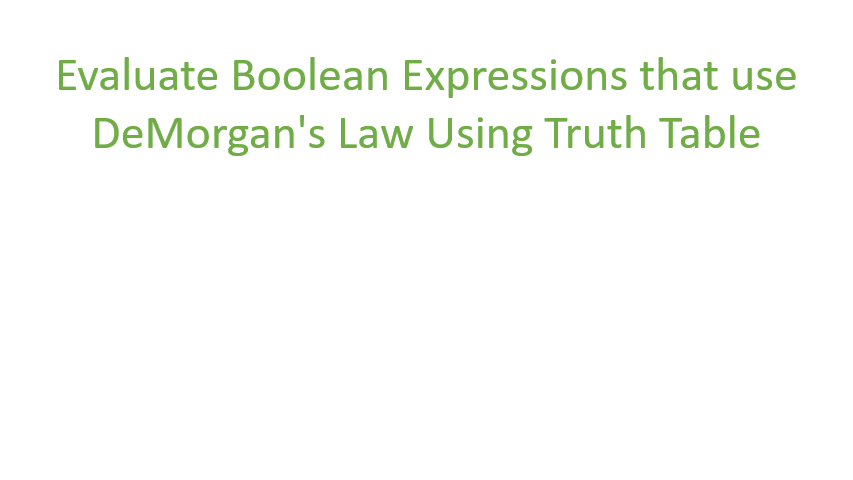Using Logic Operators
Logic Operators
Logic operators are used to combine boolean expressions. The most common ones are listed in the table below.
| Operator |
Name |
Description |
Example |
! |
not |
evaluates to true if the boolean expression is false and false if the boolean expression is true. |
!(3 > 5) evaluates to true since 3 > 5 evaluates to false.!(5 > 3) evaluates to false since 5 > 3 evaluates to true.
|
&& |
and |
evaluates to true if both boolean expressions evalute to true and false if one or both boolean expressions evaluate to false. |
true && true evaluates to true.true && false evaluates to false.false && true evaluates to false.false && false evaluates to false.
|
|| |
or |
evaluates to true if at least one of the boolean expressions evalute to true and false if both boolean expressions evaluate to false. |
true || true evaluates to true.true || false evaluates to true.false || true evaluates to true.false && false evaluates to false.
|
Truth Tables
Boolean expressions can be evaluated by using truth tables. A truth table lists all the possible values and the associated output.
Not (!) Operator
When evaluating !a, there are two possible combinations:
a can be truea can be false
Truth Table for ! Expression.

And (&&) Operator
When evaluating a && b, there are four possible combinations:
a and b can both be truea can be true and b can be falsea can be false and b can be truea and b can both be false
Truth Table for && Expression.

Or (||) Operator
When evaluating a || b, there are four possible combinations:
a and b can both be truea can be true and b can be falsea can be false and b can be truea and b can both be false
Truth Table for || Expression.

Your Turn
Try these out in the Java Playground.
- Make predictions for the values of
value1, value2, and value5.
- Run the code to check your predictions.
- What do you notice about the value of value1 and value2? Why is this the case?
- Add statements for:
value1 or value2value3 and value4value3 or value4
- Make predictions for the newly written statements.
- Run the code to check your predictions.
!(3 < 5) is equivalent to 3 >= 5. When the not (!) operator is used on an expression with a relationship operator, the equivalent expression is uses the opposite relational operator. The opposite of less than is greater than or equal to. The opposite of greater than is less than or equal to.
DeMorgan's Law
DeMorgan's Law applies in situations when a not (!) operator is being used in combination with either the and (&&) or the or (||) operators.
Truth Table to Prove DeMorgan's Law

| Rule |
Description |
Example
|
!(value1 && value2) |
evaluates to !value1 || !value2 where value1 and value2 are boolean expressions. |
!((5 > 7) && (3 !=0)) is equivalent to (5 <= 7) || (3 == 0) |
!(value1 || value2) |
evaluates to !value1 && !value2 where value1 and value2 are boolean expressions. |
!((val + 5 <= 0) || (5 == 5)) is equivalent to (val + 5 > 0) && (5 != 5) |
Short-Circuit Evaluation
If the value of a boolean expression that involves a logic operator can be determined based on only the first boolean expression, the second boolean expression is not evaluated.
And (&&) Operator Short-Circuit
If the first expression evaluates to false, the expression with the && operator evaluates to false.
This example is a popular use of short-circuit for &&. If the value of numGrades is 0, we would get a divide by 0 error when attempting totalGrades / numGrades. Checking that numGrades is not 0 before performing division can prevent this error. Try it out! Run the code as is, and then change the value of numGrades to 0.
Your Turn
- Make predictions for the values of value1, value2, and value5.
- Run the code to check your predictions.
- Modify the code to compute the division and then check to see if
numGrades is equal to 0.
Resources
Practice: Using Logic Operators